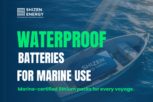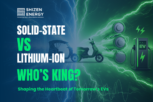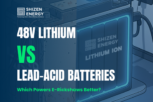
The electric vehicle revolution is gaining momentum, but it’s battery technology that’s in the race for the past few years as companies scramble to create the next-generation electric mobility storage solution. As the electric vehicle adoption accelerates globally, the question: solid-state vs lithium-ion battery is the focus of all EV manufacturers, engineers, fleet owners, investors in new technology, and manufacturers across the spectrum.
Finding out which battery is the best for EVs can help companies in the automobile and EV component manufacturing industry as well as the end consumers make informed choices. Shizen Energy India, the Indian leading E-Mobility battery OEM, has been at the forefront of this technology revolution and is sharing some solid data and information to explore.
The Evolving EV Battery Landscape
Over the last decade, lithium-ion batteries have powered the boom in electric vehicles, e-mobility, and energy storage systems. Shizen Energy India has supplied >20,000 battery packs to customers and OEMs across sectors in India for e-rickshaws, e-golf carts, solar inverters, and material handling equipment such as e-forklifts.
These lithium-ion batteries, renowned for their reliability, performance, and energy density, have become an industry standard. However, as demand for longer range, faster charging, and enhanced safety grows, the industry’s focus is rapidly shifting to a newer technology that is promising to redefine the EV world, solid-state batteries.
What is a Lithium-Ion Battery VS Solid-State Battery?
Lithium-Ion Battery:
A lithium-ion battery for electric vehicles typically consists of a liquid electrolyte that transports lithium ions between the battery’s anode and cathode during charging and discharging. This well-established technology provides a good balance of energy density, cost, and cycle life, powering most of today’s EVs, smartphones, and energy storage systems.
Solid-State Battery:
A solid-state battery for EVs, on the other hand, replaces the liquid electrolyte with a solid material, often a ceramic, glass, or polymer. This change in battery technology promises higher energy density, improved safety, and potentially longer lifespan. However, solid-state batteries are still in the R&D and early commercialization stages, with production and cost challenges to be addressed.
Solid-State Battery:
A solid-state battery for EVs, on the other hand, replaces the liquid electrolyte with a solid material, often a ceramic, glass, or polymer. This change in battery technology promises higher energy density, improved safety, and potentially longer lifespan. However, solid-state batteries are still in the R&D and early commercialization stages, with production and cost challenges to be addressed.
Technology Overview:
| Feature | Lithium-Ion Battery | Solid-State Battery |
|---|---|---|
| Electrolyte | Liquid | Solid (ceramic, glass, polymer) |
| Energy Density | 150–250 Wh/kg | 250–400+ Wh/kg (potential) |
| Charging Speed | 30–80% in 30–60 min (fast charging EV batteries) | Potentially faster, but not yet proven at scale |
| Safety | Risk of thermal runaway, fire | Improved safety, less flammable |
| Cycle Life | 1,000–5,000 cycles | 2,000–5,000+ cycles (projected) |
| Cost | $100–150/kWh (declining) | $300–500+/kWh (currently high) |
| Scalability | Mature, global supply chain | Early stage, limited production |
Pros & Cons of Each Technology
1. Lithium-Ion Battery for Electric Vehicles
Pros:
- Proven, mature technology with established manufacturing and supply chains
- Competitive cost, benefiting from economies of scale and continuous improvements
- Good balance of energy density, lifespan, and charging speed for most applications
- Widely available and supported by global OEMs and battery manufacturers
Cons:
- Safety concerns, including overheating, fire risk, and thermal runaway
- Limited energy density compared to the theoretical potential of solid-state
- Degradation over time, particularly under high temperatures or fast charging
2. Solid-State Battery for EV
Pros:
- Higher energy density: Enables longer driving range or smaller, lighter battery packs (energy density comparison)
- Enhanced safety: Solid electrolytes are non-flammable, reducing fire risk (EV battery safety)
- Potential for faster charging and longer cycle life (battery lifespan EV)
- Wider operating temperature range
Cons:
- High production costs and complex manufacturing processes
- Scalability challenges: Few factories, limited supply of solid electrolytes
- Not yet commercially available in mass-market EVs
- Technical hurdles, including dendrite formation, interface stability, and durability
Current Industry Adoption: Who’s Using What?
Lithium-Ion:
Virtually all current EVs – from Tesla, BYD, Hyundai, and Nio to Tata and Mahindra – use lithium-ion batteries. Shizen Energy India alone has supplied battery packs for over 20,000+ e-rickshaws, electric golf carts, solar inverters, and material handling equipment such as e-forklifts to customers and OEMs across India. The global lithium-ion supply chain is extensive, with continuous improvements in cost, safety, and performance.
Solid-State:
Solid-state batteries are currently in the R&D and pilot production stage, with significant investments from major automakers and battery companies. Some of the key players in solid-state battery R&D include:
- Toyota: Announced plans to commercialize solid-state batteries by 2027–2028. Toyota’s solid-state batteries are in prototype stages and undergoing testing
- QuantumScape: Volkswagen-backed startup developing solid-state cells with promising lab results, but not yet in commercial vehicles
- Samsung SDI: Heavy investment in solid-state R&D for automotive applications
- Other players: BMW, Ford, Hyundai, and CATL are also investing in solid-state research.
No major automaker has yet launched a mass-market EV with a solid-state battery, though several limited pilot programs and concept vehicles have been announced.
Energy Density Comparison: The Key to Range
EV Battery Safety: Addressing the Pain Points
Safety remains a top concern for EV buyers and fleet operators. While lithium-ion batteries are generally safe, they can catch fire if damaged or improperly managed. Solid-state batteries offer a step-change in safety, with non-flammable solid electrolytes that could make EVs even more reliable.
Fast Charging EV Batteries: The Next Frontier
Cost and Scalability: The Biggest Hurdles for Solid-State
Despite the promise of solid-state batteries, they face significant cost and production challenges. Manufacturing solid electrolytes at scale is difficult and expensive, with current estimates of $300–500/kWh – two to three times the cost of lithium-ion batteries. Building new factories, developing supply chains, and ensuring consistent quality are other major hurdles to overcome. Most experts agree that solid-state batteries will remain a premium, low-volume product until at least 2030.
Future Outlook: What to Expect by 2030
The future of EV battery technology by 2030 will likely be a mix of incremental improvements in lithium-ion and the gradual introduction of solid-state batteries in high-end or specialized vehicles. As costs come down and production scales, solid-state batteries could become mainstream, but lithium-ion will likely continue to dominate the market for the next 5–10 years.
Frequently Asked Questions
No mass-market EVs use solid-state batteries as of 2025. Prototypes and pilot programs exist, but the technology is expected to be commercially rolled out by around 2027–2030.
Solid-state batteries are expected to have a longer cycle life (2,000–5,000 cycles) than lithium-ion batteries (1,000–2,000 cycles), but real-world data is still limited.
High production costs, technical challenges, and limited manufacturing capacity are the main barriers. It will take several years for the technology to mature and scale up.
Conclusion: A Balanced View
Lithium-ion batteries are clearly winning the race right now in the segment of EV batteries for electric vehicles as the backbone of the EV industry because of its maturity, cost-effectiveness, and proven performance. Indian E-Mobility and battery OEM Shizen Energy India has been in the forefront in this space and providing high-quality, reliable, innovative lithium battery solutions to customers and OEMs in the Indian market.
Solid-state battery for EVs, however, is a technology to watch in the coming years, as their advantages of higher energy density, improved safety, and longer lifespan could make it the future of EV battery technology. Stay tuned to learn more about EV battery technology and check out how our advanced lithium battery solutions can power your sustainable future.




